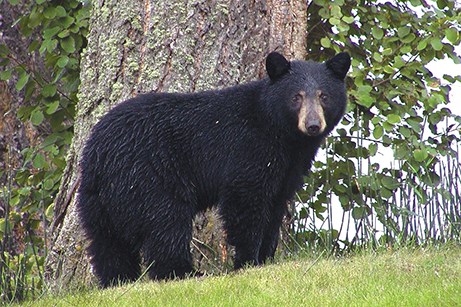Posters about local bear activity are affixed to mailboxes and utility poles in Gibsons, Sechelt and rural areas of the Sunshine Coast. Canvassers are providing education about wildlife attractants door-to-door. Emergency phone numbers are available on their website in case of bear conflicts.
But this isn’t the Conservation Officer Service.
Instead, these activities and resources are the culmination of a year’s worth of work by the Sunshine Coast Bear Alliance.
The group, which launched last fall on Facebook, received its non-profit status in March 2020 and has grown to 540 members, with about 15 core active volunteers. Its website is replete with resources for managing attractants, understanding bear behaviour, as well as links to publications by established researchers such as Wildlife Research Institute of Minnesota’s Lynn L. Rogers.
The organization liaises with other bear groups across the country, including North Shore Black Bear Society, North American Bear Centre and Bear with Us Centre for Bears.
“Our goal is to foster a pragmatic understanding of bears and an appreciation of them, ensuring both the bears and the people are safe,” founding member Diane Henley told Coast Reporter.
In addition to educational efforts, they are lobbying local governments to adopt separate wildlife attractant bylaws along with “significant fines” that could increase for repeated offences.
They are fundraising to conduct a habitat protection plan and wildlife corridor study to establish corridor designations exclusively for wildlife in official community plans and in perpetuity.
And they are pushing for changes to how the COS operates, specifically the agency’s mandate to euthanize wildlife such as bears if they are deemed a threat to the public and cannot be relocated.
“It is an emotional issue,” acknowledged Henley. “We just feel these bears deserve to live out their lifespan rather than being killed when they’re three years old because they got into someone’s garbage.”
To that end, the Alliance wants the COS to “prioritize preventative measures, educational tools and equipment, and rehabilitation prior to lethal measures.” They want independent oversight of the COS and more wildlife attractant fines and charges, among other changes.
Long history
In an email to Coast Reporter, COS Sgt. Dean Miller said the COS has a long history of conflict prevention work.
He called local COS “instrumental” in advocating and fundraising to establish wildlife conflict prevention strategies and programs such as WildSafe BC.
“I think it is important to lay out a complete history of the management of wildlife on the Coast in reference to what the Bear Alliance is doing. It speaks to the efforts we have made to reduce conflicts and educate the public,” Miller said.
Examples of those efforts include three attempts since 2005 to establish “consistent volunteer groups” to assist in educating the public on attractant management in years when funding wasn’t available for other programs. It’s also meant working with local businesses, residents and kids camps to reduce attractants, and encouraging larger institutions such as parks, schools and camps to invest in “bear proof/resistant infrastructure.”
Combined, said Miller, those efforts have resulted in “a significant reduction in conflicts.”
The COS has also used attractant audits and “enforcement projects” to address attractant issues with residents.
Miller said the COS is working with members of the Bear Alliance “to supplement our reduction efforts but as a governing body for wildlife still hold the liability when wildlife becomes potentially dangerous.”
Behaviour model
He said with black bears, the COS “uses an animal behaviour decision model to determine if there is ever a threat to public safety.”
And he added: “The province has provided the COS with some compliance and enforcement tools in the last few decades that help us reduce attractant mismanagement in our communities. We will continue to educate and enforce a higher standard of attractant management in our community until a significant cultural change has occurred. If groups such as the Bear Alliance want to promote this messaging to remind the public of this standard, the COS will continue to work with them.”
The Bear Alliance also acknowledged a desire to continue to collaborate with the COS as it aims to achieve Bear Smart Community status – a rigorous provincial program supported by the COS and attained by only eight communities in B.C.
“Together we are looking ahead to the possibility of becoming a Bear Smart Community as this requires a concerted effort between the community, local governments, waste management providers and the COS,” said Henley.



